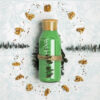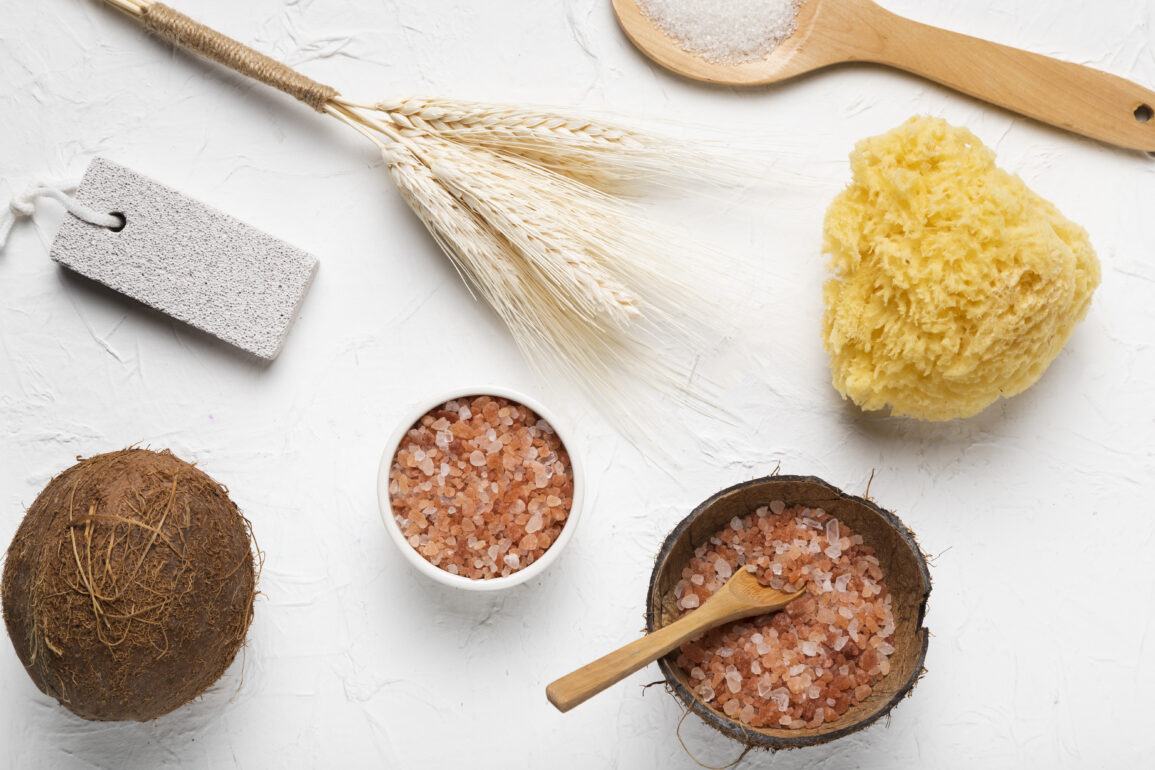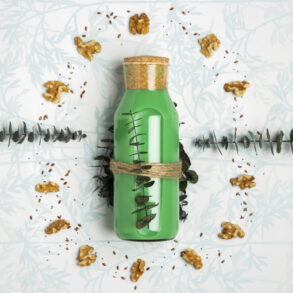Introduction to Ayurvedic Skin Care
What is Ayurveda?
Ayurveda is the ancient Indian system of holistic medicine. It has been in practice for over 5,000 years. Rooted in nature and balance, it believes that true health is achieved when the body, mind, and spirit have a balance. Ayurveda is derived from two Sanskrit words: Ayur meaning “life” and Veda meaning “knowledge” or “science.” This science of life guides us on how to live in alignment with nature for optimal well-being, including skincare.
When it comes to skincare, Ayurveda doesn’t take a one-size-fits-all approach. It considers individual constitution, or doshas Vata, Pitta, and Kapha and tailors skin treatments based on these energies. Ayurvedic skincare emphasizes nourishment, detoxification, and rejuvenation through natural ingredients. Many of these double as gentle exfoliators suitable even for the most sensitive skin.
In contrast to modern cosmetic products, which often contain harsh chemicals, Ayurveda relies on herbs, flowers, oils, and minerals that have stood the test of time. These remedies don’t just exfoliate but also help balance internal and external factors that cause skin issues.
Ayurvedic Perspective on Skin Types
Ayurveda categorizes skin based on doshas:
- Vata Skin (Air + Ether): Thin, dry, prone to premature aging and fine lines.
- Pitta Skin (Fire + Water): Sensitive, prone to redness, inflammation, and breakouts.
- Kapha Skin (Water + Earth): Oily, thick, may develop large pores and be acne-prone.
Sensitive skin usually aligns with Pitta dosha, as it reacts quickly to environmental changes, heat, and certain ingredients. However, Vata types can also experience sensitivity due to dryness and lack of oil, while Kapha skin may become reactive due to clogged pores.
Understanding your dosha is the first step in crafting the perfect natural exfoliator for sensitive skin based on Ayurvedic science. The goal is to maintain harmony by choosing exfoliants that gently cleanse without disturbing the skin’s natural balance.
Understanding Sensitive Skin
Characteristics of Sensitive Skin
Sensitive skin isn’t just a passing phase; it’s a condition that requires constant care. It’s usually characterized by:
- Redness and irritation
- Burning or stinging sensations
- Flaking or peeling
- Tightness after cleansing
- Visible broken capillaries
- Prone to rashes or bumps
If this sounds like you, you’re not alone. Millions deal with skin that overreacts to seemingly harmless ingredients or environmental changes. That’s why it’s critical to treat sensitive skin with respect—especially when exfoliating.
Exfoliation removes dead skin cells and helps reveal brighter, smoother skin underneath. But for sensitive skin, harsh exfoliants can do more harm than good. This is because it strips the skin barrier and causes inflammation. That’s where Ayurveda steps in, offering gentle alternatives through nature.
Common Triggers for Sensitivity
Understanding what causes your skin to flare up can help prevent future irritation. Some of the most common triggers include:
- Fragrance and alcohol in skincare products
- Synthetic exfoliating beads or scrubs
- Environmental pollutants
- Temperature extremes
- Hormonal fluctuations
- Overuse of exfoliants or acids (AHAs/BHAs)
Using the natural exfoliators for sensitive skin based on Ayurvedic science helps avoid most of these triggers. Ayurvedic exfoliants are usually made from food-grade ingredients and herbal powders that are naturally soothing and nourishing.
Importance of Gentle Exfoliation
Exfoliation isn’t just about removing dead skin cells. It also helps:
- Improve blood circulation
- Unclog pores
- Even out skin tone
- Enhance absorption of skincare products
But when done incorrectly—especially with sensitive skin—it can damage the skin’s protective barrier and lead to chronic irritation. That’s why Ayurveda suggests exfoliating with ingredients that have both physical and medicinal benefits.
For example, Chickpea flour gently removes grime and excess oil while calming inflammation. Rose petal powder soothes while promoting glow. These aren’t just exfoliants—they’re holistic skin foods. Incorporating these into your routine not only ensures safety but also supports skin health long-term.
The Role of Exfoliation in Ayurveda
Why Exfoliation is Essential According to Ayurveda
In Ayurvedic texts, exfoliation is more than a cosmetic step—it’s a spiritual and physical detox. The act of removing old cells, impurities, and toxins from the skin is known as Udvartana. This is a form of dry massage with herbal powders. This ancient practice isn’t limited to the face; it’s often applied to the entire body to stimulate lymphatic flow and remove ama (toxins).
For facial skincare, Ayurveda emphasizes exfoliants that also pacify aggravated doshas. Sensitive skin, usually due to Pitta imbalance, benefits from cooling, anti-inflammatory, and soothing substances. Ayurveda recommends exfoliating 2–3 times a week using gentle, pitta-pacifying ingredients such as sandalwood powder, oatmeal, or rose powder.
This dual-purpose approach—physical exfoliation and energetic balancing—sets Ayurveda apart. You’re not just scrubbing away dead cells. Instead, you are restoring balance to your skin and inner body systems.
Ayurvedic Terms for Exfoliation (Udvartana, Lepa, etc.)
Let’s decode some of the Ayurvedic terms related to exfoliation:
- Udvartana: The practice of massaging the skin with herbal powders, typically dry powders or mixed with oil, to exfoliate, detoxify, and reduce fat accumulation.
- Lepa: Application of herbal pastes on the skin to draw out impurities and soothe inflammation. Often used post-exfoliation.
- Pralepa: A thinner version of Lepa, applied for its cooling and calming effects.
- Abhyanga: Oil massage, often combined with exfoliation to balance Vata dosha and nourish the skin.
These practices are therapeutic and rejuvenating, especially for those with sensitive skin. The mixture of gentle exfoliation and dosha-specific oils makes these treatments both healing and beautifying.
Balance of Doshas and Skin Health
According to Ayurveda, your skin reflects the inner balance of your doshas:
- Vata imbalance can make skin dry, flaky, and prone to sensitivity.
- Pitta imbalance often leads to rashes, redness, acne, and rosacea.
- Kapha imbalance causes clogged pores, dullness, and breakouts.
The natural exfoliators for sensitive skin based on Ayurvedic science are selected to pacify Pitta (and sometimes Vata). This is why they are cooling, anti-inflammatory, and gentle. Ingredients like aloe vera, rose, sandalwood, turmeric, and milk not only exfoliate but help bring the doshas back into harmony, leading to clearer, healthier skin.
Top 10 Natural Exfoliators for Sensitive Skin Based on Ayurvedic Science
1. Oatmeal
Oatmeal is a superstar when it comes to calming inflamed, sensitive skin. Known for its snigdha (unctuous) and sheeta (cooling) properties in Ayurveda. It is the perfect choice for pacifying Pitta dosha. Finely ground oatmeal acts as a very mild scrub that gently lifts dead skin cells without disturbing the skin’s barrier.
Benefits:
- Soothes itching and redness
- Moisturizes while exfoliating
- Rich in antioxidants
How to Use:
Mix 1 tablespoon of colloidal oatmeal with rose water or milk to form a paste. Apply in circular motions and wash off after 10 minutes.
Pro Tip: Add a few drops of lavender oil for added relaxation and anti-inflammatory benefits.
2. Sandalwood Powder
Sandalwood (Chandan) has been used in Ayurvedic beauty rituals for centuries. It cools, calms, and purifies, making it ideal for Pitta-sensitive skin. While not abrasive like traditional scrubs, it gently polishes the skin, reduces inflammation, and promotes a radiant glow.
Benefits:
- Natural antiseptic and astringent
- Reduces redness and acne
- Evens out skin tone
How to Use:
Mix sandalwood powder with rose water or aloe vera gel. Gently apply and let it dry for 10–15 minutes before rinsing off.
3. Rose Petals Powder
Rose petals are more than just romantic—according to Ayurveda. They carry cooling and soothing properties ideal for sensitive, inflamed, or reactive skin. The natural oils in rose petals help retain moisture, while the powdered texture works as a delicate exfoliant.
Benefits:
- Calms redness and inflammation
- Gently buffs away dead cells
- Offers antioxidant protection
How to Use:
Grind dried rose petals into a fine powder or buy organic rose powder. Mix with yogurt or milk and apply as a mask. Rinse off gently using circular motions.
Extra Tip: Add a pinch of turmeric for antibacterial properties.
4. Chickpea Flour (Besan)
Chickpea flour, known as Besan in India, is a staple in Ayurvedic beauty recipes. It’s excellent for all three doshas and especially gentle for sensitive skin. Its mildly grainy texture works well to cleanse pores, remove impurities, and reduce oiliness without stripping the skin.
Benefits:
- Balances oil production
- Helps remove tan and pigmentation
- Reduces acne and blackheads
How to Use:
Mix 1 tablespoon of Besan with a pinch of turmeric and enough raw milk or yogurt to form a paste. Apply evenly, let it sit for 10–15 minutes, then gently exfoliate before rinsing.
5. Orange Peel Powder
Dried orange peel powder is rich in vitamin C and natural enzymes that brighten and refresh the skin. In Ayurveda, citrus fruits are considered Kapha-pacifying. But when used gently, they benefit sensitive and Pitta skin too—especially in controlled amounts.
Benefits:
- Promotes brighter complexion
- Gently removes dead skin layers
- Fights dullness and uneven tone
How to Use:
Mix orange peel powder with rose water or honey to create a paste. Apply to the face and scrub lightly. Use no more than twice a week for sensitive skin.
Note: Always patch-test first, as citrus can occasionally be reactive for hyper-sensitive skin types.
Detailed Table of Ayurvedic Exfoliators
| Ayurvedic Exfoliator | Dosha Suitability | Key Benefits | Recommended Use Frequency | Ideal Base Ingredient |
|---|---|---|---|---|
| Oatmeal | Pitta, Vata | Soothes irritation, hydrates, gently exfoliates | 2-3 times a week | Milk, Rose Water |
| Sandalwood Powder | Pitta | Cools inflammation, tones skin | 1-2 times a week | Aloe Vera, Rose Water |
| Rose Petals Powder | Pitta, Vata | Calms redness, hydrates, provides mild exfoliation | 2-3 times a week | Yogurt, Milk |
| Chickpea Flour (Besan) | Tridoshic | Removes tan, oil control, smoothens texture | 2-3 times a week | Yogurt, Turmeric, Milk |
| Orange Peel Powder | Kapha, Pitta | Brightens skin, unclogs pores | 1-2 times a week | Honey, Rose Water |
| Aloe Vera + Rice Flour | Pitta, Vata | Hydrating, gentle exfoliation | 2 times a week | Fresh Aloe Vera Gel |
| Masoor Dal (Red Lentils) | Kapha, Vata | Deep exfoliation, removes blackheads | 1 time a week | Raw Milk |
| Almond Meal | Vata | Nourishes, gently scrubs, moisturizes | 2 times a week | Honey, Milk |
| Raw Milk & Turmeric | Pitta, Vata | Softens, brightens, light exfoliation | 2-3 times a week | Use as is |
| Neem Leaves Paste | Pitta, Kapha | Antibacterial, clears acne, unclogs pores | 1-2 times a week | Water, Rose Water |
This chart is essential for choosing the natural exfoliators for sensitive skin based on Ayurvedic science that best suit your individual constitution and needs.
How to Choose the Right Exfoliator Based on Skin Type
Identifying Your Dosha (Vata, Pitta, Kapha)
Before jumping into any skincare routine, Ayurveda urges you to first identify your dominant dosha. Here’s a quick overview:
- Vata (Air + Ether): Dry, thin, flaky, cool to touch, fine pores
- Pitta (Fire + Water): Sensitive, oily in T-zone, prone to redness or acne
- Kapha (Water + Earth): Thick, oily, large pores, dull appearance
There are numerous free Ayurvedic dosha quizzes online or you can consult an Ayurvedic practitioner for a proper evaluation. Once you know your dosha, you can customize exfoliation using the right ingredients.
Dosha-Based Recommendations
- For Vata Skin (Dry/Sensitive):
- Best Exfoliators: Almond meal, oatmeal, raw milk
- Frequency: 1–2 times/week
- Avoid: Over-exfoliation, clay masks that increase dryness
- For Pitta Skin (Sensitive/Oily):
- Best Exfoliators: Rose powder, sandalwood, aloe vera
- Frequency: 2–3 times/week
- Avoid: Harsh scrubs, citrus peels, synthetic products
- For Kapha Skin (Oily/Clogged):
- Best Exfoliators: Chickpea flour, masoor dal, orange peel
- Frequency: 3 times/week
- Avoid: Rich, oily exfoliants like almond paste
Matching your exfoliator to your dosha ensures long-term effectiveness and avoids common issues like breakouts, dryness, or irritation. It’s the heart of natural exfoliators for sensitive skin based on Ayurvedic science—personalized care from nature’s pharmacy.
DIY Ayurvedic Exfoliator Recipes for Sensitive Skin
Step-by-Step Guides
Crafting your own exfoliator is not only cost-effective, it allows you to control every ingredient that touches your skin. The beauty of Ayurvedic formulations is that they rely on simple, kitchen-friendly components trusted for centuries.
1. Oatmeal & Rose Water Scrub
- Ingredients: 2 tsp colloidal oatmeal, 2 tsp rose water
- Instructions: Mix both to form a paste. Gently massage onto face for 2–3 minutes, then rinse with lukewarm water.
2. Sandalwood & Aloe Gel Mask
- Ingredients: 1 tsp sandalwood powder, 2 tsp pure aloe vera gel
- Instructions: Blend together, apply as a mask. Let it sit for 10 minutes, rinse off while gently massaging.
3. Almond Meal & Milk Scrub
- Ingredients: 2 tsp almond meal, 1 tbsp raw milk
- Instructions: Apply to damp skin, scrub in circular motions for 2 minutes, wash off.
4. Neem Paste Exfoliant
- Ingredients: Handful of neem leaves, few drops of rose water
- Instructions: Grind neem leaves into a paste, add rose water. Use as a scrub or a mask once weekly.
Precautions to Take When Preparing at Home
- Always patch test: Sensitive skin can be unpredictable. Apply a small amount on your wrist before using it on your face.
- Use non-metallic bowls: Especially when mixing ingredients like turmeric or sandalwood.
- Avoid harsh abrasives: Skip sugar, salt, or walnut shells—too coarse for sensitive skin.
- Use fresh ingredients: Homemade products lack preservatives. Make small batches and use them within a few days.
- Avoid over-exfoliating: Even the gentlest scrub can cause irritation if used too frequently.
These homemade solutions truly embody the essence of natural exfoliators for sensitive skin based on Ayurvedic science. They are gentle, pure, and deeply healing.
Benefits of Natural Ayurvedic Exfoliators
Detailed Advantages
Let’s unpack the long list of benefits Ayurvedic exfoliators bring to sensitive skin. These are supported by centuries of usage and modern skin science:
1. Calms Inflammation
Ingredients like rose, sandalwood, and aloe vera naturally reduce redness and calm the skin.
2. Gentle Yet Effective
Unlike chemical exfoliants that might burn or sting, Ayurvedic exfoliants work softly over time. They respect your skin barrier.
3. Nourishes Deeply
Most Ayurvedic exfoliants are rich in nutrients like vitamins, minerals, and natural oils. They all offer both cleansing and conditioning benefits.
4. Promotes Radiance
Ingredients like orange peel and masoor dal promote a healthy glow by improving blood flow and removing surface dullness.
5. Adaptable to Skin Types
Whether you’re Vata-dry or Pitta-sensitive, there’s a natural solution for you. It’s skincare tailored for your unique constitution.
6. Reduces Dependency on Synthetics
You cut out harmful chemicals, fragrances, and microplastics from your skincare regime.
7. Long-Term Skin Resilience
Regular use improves the skin’s tolerance, elasticity, and hydration over time.
When you incorporate natural exfoliators for sensitive skin based on Ayurvedic science, you’re not just caring for the surface. You are supporting your skin’s ecosystem holistically.
Drawbacks and Considerations
Possible Side Effects
Even natural products can sometimes trigger reactions—especially if not suited to your skin or improperly prepared.
1. Allergies
Some people may be allergic to herbs like neem, turmeric, or milk. Always conduct a patch test.
2. Over-Exfoliation
Yes, even gentle scrubs can cause micro-tears if rubbed too vigorously or used too often.
3. Ingredient Sensitivity
Ingredients like citrus peel can irritate ultra-sensitive skin due to natural acids.
4. Shelf Life Issues
Homemade products don’t last long. Using spoiled pastes or powders can cause breakouts or rashes.
Contraindications Based on Skin Conditions
- Rosacea: Avoid any exfoliation during flare-ups. Use only ultra-calming ingredients like oatmeal or aloe.
- Active Acne: Do not use grainy exfoliants that could spread bacteria. Stick with turmeric or neem in paste form.
- Eczema or Psoriasis: Exfoliation can worsen symptoms. Moisturization and calming masks are better choices.
While natural exfoliators for sensitive skin based on Ayurvedic science offer numerous benefits, mindful use is essential. Listen to your skin, and less is often more.
Ayurvedic Skincare for Sensitive Skin
Morning and Evening Routine
A well-structured daily skincare regimen is the secret to managing sensitive skin.
Morning Routine:
- Cleanse: Use rose water or milk
- Exfoliate: Use a mild exfoliant 2–3 times a week
- Tone: Dab rose water or cucumber water
- Moisturize: Apply almond oil or aloe vera
- Protect: Use a natural SPF like sandalwood paste or zinc-based sunscreen
Evening Routine:
- Cleanse: Raw milk or chickpea flour mixed with water
- Exfoliate: Once or twice a week if not done in the morning
- Mask: Rose or sandalwood-based calming mask
- Moisturize: Brahmi oil or sesame oil (for Vata), coconut oil (for Pitta)
Seasonal Adjustments for Skincare
- Summer (Pitta Season): Use more cooling ingredients like aloe, rose, sandalwood.
- Winter (Vata Season): Focus on nourishment—almond oil, ghee, sesame oil.
- Monsoon (Kapha Season): Use detoxifying agents like neem, turmeric, and orange peel.
Sensitive skin isn’t static—it changes with your environment, mood, and diet. Ayurveda recognizes this and encourages seasonal care, making the case even stronger for adopting natural exfoliators for sensitive skin based on Ayurvedic science as part of your lifestyle.
Case Studies and Testimonials
Real Experiences with Ayurvedic Exfoliators
Let’s dive into real-world feedback to understand the impact of natural exfoliators for sensitive skin based on Ayurvedic science:
Case Study 1: Rhea (29, Mumbai – Pitta Skin Type)
Rhea struggled with hormonal acne and rosacea flare-ups. After switching to a rose petal and sandalwood exfoliator recommended by her Ayurvedic therapist, her skin visibly calmed within 2 weeks. Within 6 weeks, inflammation reduced by 70%.
Case Study 2: Daniel (35, California – Vata-Pitta Mixed Skin)
Daniel experienced flakiness and burning after using commercial glycolic acid scrubs. He switched to a weekly oatmeal and aloe vera mask. “I haven’t seen any redness since,” he shared. “And my skin feels soft and clean without any dryness.”
Case Study 3: Ananya (42, Delhi – Kapha Dominant)
Ananya had persistent blackheads and dullness. Using orange peel and masoor dal twice a week showed marked improvement. “The natural exfoliation felt more like therapy than a chore,” she said.
These stories reinforce the power of Ayurveda—not just in addressing skin issues, but in restoring balance, resilience, and confidence.
Expert Tips and Precautions
Advice from Ayurvedic Practitioners
Renowned Ayurvedic skincare expert Dr. Meenakshi Sharma advises:
“Don’t treat exfoliation as a mechanical task. Treat it as an act of self-care. Your skin listens.”
Here are some additional expert-backed tips:
- Use exfoliation during Pitta hours (10 AM – 2 PM) for best results.
- Don’t combine too many ingredients; simplicity ensures better absorption.
- Follow up with herbal toners like rose or vetiver water to close pores.
- Avoid cold water after exfoliation, especially for Vata-prone skin.
- Keep a food diary—many skin irritations start with internal imbalances, especially in Pitta types.
Ayurveda sees the skin as a mirror of your gut, emotions, and lifestyle. True healing comes from syncing both internal and external rituals.
Ayurvedic Herbs and Oils to Complement Exfoliation
Essential Oils and Carrier Oils
Exfoliation is just one part of Ayurvedic skincare. Post-scrub hydration is key for sensitive skin.
Top Carrier Oils:
- Almond Oil: Nourishes Vata and Pitta skin types
- Coconut Oil: Best for hot climates and Pitta skin
- Jojoba Oil: Mimics sebum, suits all doshas
- Sesame Oil: Great for Vata in cold seasons
Essential Oils (in tiny amounts):
- Lavender: Calms irritation
- Chamomile: Soothes inflammation
- Tea Tree: For mild acne (diluted heavily)
Herbal Infusions and Decoctions
Boil herbs like neem, tulsi, or manjistha in water and use the cooled decoction as a rinse or toner. These natural waters soothe, balance pH, and reinforce exfoliation effects.
Modern Science Meets Ayurveda
Scientific Studies on Ayurvedic Ingredients
Many modern studies now validate what Ayurveda has said for millennia.
- Oatmeal: FDA recognizes colloidal oatmeal for eczema.
- Neem: Proven antimicrobial properties, useful in treating acne.
- Rose Petals: Rich in flavonoids and antioxidants.
- Sandalwood: Reduces inflammation, confirmed by dermatological studies.
A study published in The Journal of Ethnopharmacology concluded that Ayurvedic herbs like turmeric, sandalwood, and neem exhibit powerful anti-inflammatory and antioxidant effects, ideal for treating sensitive skin.
Dermatological Opinions
Many dermatologists now recommend integrating gentle Ayurvedic ingredients into skincare routines, especially for patients sensitive to retinoids or chemical exfoliants.
Dr. Rajan Batra, MD, remarks:
“Natural exfoliators from Ayurveda offer a slower, but more sustainable path to skin health.”
Where to Buy Authentic Ayurvedic Ingredients
Online and Offline Trusted Sources
Online Platforms:
- Kama Ayurveda
- Forest Essentials
- Ayurveda Experience
- Patanjali
- Banyan Botanicals (for global shipping)
Offline Stores:
- Local Ayurveda clinics
- Indian grocery stores with organic sections
- Panchakarma wellness centers
Quality Checking Tips
- Look for organic and pesticide-free labels
- Prefer powders in glass jars over plastic packaging
- Check for certifications: USDA Organic, Ecocert, GMP
- Always smell and test for freshness—rancid oils and stale powders are ineffective or harmful
Choosing high-quality products increases the benefits of natural exfoliators for sensitive skin based on Ayurvedic science and reduces the risk of adverse reactions.
Conclusion
Exfoliating sensitive skin doesn’t have to be a frustrating or risky affair. When you turn to natural exfoliators for sensitive skin based on Ayurvedic science, you embrace a tradition that has honored the skin’s rhythms for over 5,000 years. These ingredients are more than mere scrubs. They are herbal healers, designed to calm, cleanse, and balance.
Whether you identify as Vata, Pitta, or Kapha, there’s a natural remedy waiting to bring harmony back to your skin. From gentle oatmeal and rose to potent neem and sandalwood, Ayurvedic exfoliants respect your skin’s sensitivity. This is why they deliver lasting glow and strength.
In a world overwhelmed by synthetic solutions, Ayurveda invites us to return to our roots. To rediscover the timeless secrets of true beauty.
FAQs
1. How often should I exfoliate if I have sensitive skin?
You should exfoliate 1–2 times a week using gentle ingredients like oatmeal, rose powder, or chickpea flour. Overdoing it can lead to irritation.
2. Can I use Ayurvedic exfoliators daily?
No. Even natural exfoliators should not be used daily. Give your skin time to heal and regenerate—2–3 times per week is ideal.
3. What should I avoid when exfoliating sensitive skin?
Avoid physical exfoliants with harsh textures (like walnut shells), acids (like AHA/BHA), and synthetic fragrances. Stick to natural, Ayurvedic ingredients tailored to your dosha.
4. Are these ingredients safe for rosacea or eczema?
Some are, but caution is needed. Oatmeal, aloe vera, and rose water are usually safe. Always patch test and consult your dermatologist or Ayurvedic expert before using.
5. How long until I see results from Ayurvedic exfoliation?
Typically, you’ll see a reduction in redness or dullness within 1–2 weeks, with clearer skin emerging after consistent use for 4–6 weeks.










